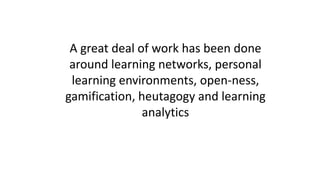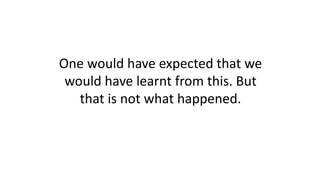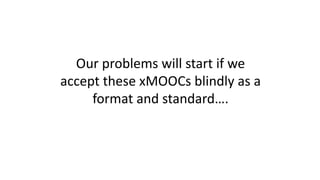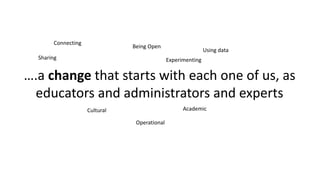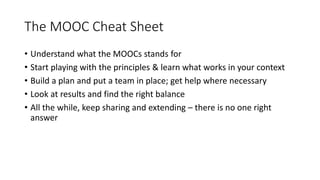edTechNext Higher Education Technology Conference Feb 28, 2015
- 1. Higher Education Technology Conference (HETC) 2015 Incorporating Technology-Enhanced Pedagogies Leading in the Digital Age | Feb 28, 2015
- 2. Half of what I say is meaningless, but I say it so that the other half may reach you…
- 3. Most of us have spent a significant part of our lives in classrooms
- 4. Sage on the stage Confined space Fixed curriculum Standard assessments Small cohorts Low or zero tech Expensive experts
- 5. This approach has had significant critics worldwide Not learner centric Unable to scale Industrial age approach Tyranny of design Not situated Low employability
- 6. Who wanted a Guide by the side approach instead More learner centric Scalable Emergent and intelligent ecosystems More situated Community based Teachers as expert learners
- 7. Meanwhile, elearning aped the traditional models and failed miserably Learning Objectives Blooms Taxonomy ARCS, ADDIE Development models Solo learning experiences No real way to estimate RoI Boilerplate low cost templates BPO production offshore Death by Multiple choice questions Instructional Design
- 8. eLearning was designed to solve problems of access, standardization, cost and efficiency for large Western organizations …not really the problems of learners and teachers
- 9. However, eLearning 2.0 proponents recognized the power of technology and new participatory pedagogies to transform learning
- 10. cMOOCs were born in 2008 as a confluence of extensive work and research on Informal Learning, Communities of Practice, network science, Chaos, complex adaptive systems, social media and neuroscience
- 11. A great deal of work has been done around learning networks, personal learning environments, open-ness, gamification, heutagogy and learning analytics
- 12. One would have expected that we would have learnt from this. But that is not what happened.
- 13. In 2011, some folks literally put brand + money together to position MOOCs as something new and revolutionary…the xMOOCs
- 14. They understood M.O.O.C as acronym that merely extended the existing system to scale at low or zero cost…
- 15. Massive – not just numbers Open – not just free for all Online – not just for access anywhere, anytime Courses – bit of a misnomer, really
- 16. …and now MOOC has unfortunately become a buzzword to promote methods that have been found inadequate
- 17. Which is why the xMOOCs have performed miserably equally quickly…and at a large scale High dropout ratesSage on the Stage approach Video fixation Brand-led, not substantiated by theory Dearth of positive evidence on outcomes
- 18. Our problems will start if we accept these xMOOCs blindly as a format and standard….
- 19. ….and ignore new ways of teaching-learning, new heutagogy and technology that are being actively researched since the turn of the century
- 20. …and we need to refocus ourselves on the key challenges in any form of online learning Access Language Retention Engagement Low usage of analytics Digital learning competencies for students, teachers and administrators Effectiveness Local context Lack of learning networks
- 21. ….which is why we need a call for urgent change Research Awareness generation Design Development Measurements Standards Data
- 22. ….a change that starts with each one of us, as educators and administrators and experts Sharing Connecting Being Open Experimenting Cultural Academic Operational Using data
- 23. Know. Do. Be! …a change which really marks a shift in paradigm
- 24. …the capability to learn by making connections transcends the capability to know and to do
- 25. Start with YOU Create an Identity Harness & extend your networks Advocate, Participate, Share and Extend Navigate the choices to suit your needs Get your network engaged and integrated Embrace a new way of “be”-ing
- 26. The MOOC Cheat Sheet • Understand what the MOOCs stands for • Start playing with the principles & learn what works in your context • Build a plan and put a team in place; get help where necessary • Look at results and find the right balance • All the while, keep sharing and extending – there is no one right answer
- 27. “The current search for new educational funnels must be reversed into the search for their institutional inverse: educational webs which heighten the opportunity for each one to transform each moment of his living into one of learning, sharing, and caring.” Ivan Illich, forty years ago, stated
- 28. …let us make that change happen











